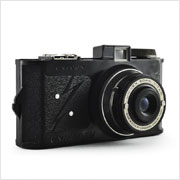Univex Iris
The Univex Iris is a relatively high-end metal viewfinder camera debuted in 1938 by the Universal Camera Corporation. Universal employed a “razor and blades” approach to their products which means that, like all Univex cameras manufactured up to this point, the Iris can only be used with Universal’s proprietary film. This initially ingenious strategy became a massive liability when Gevaert–the Belgian firm that produced film on Universal’s behalf–was soon forced to cease production because of World War II.


















